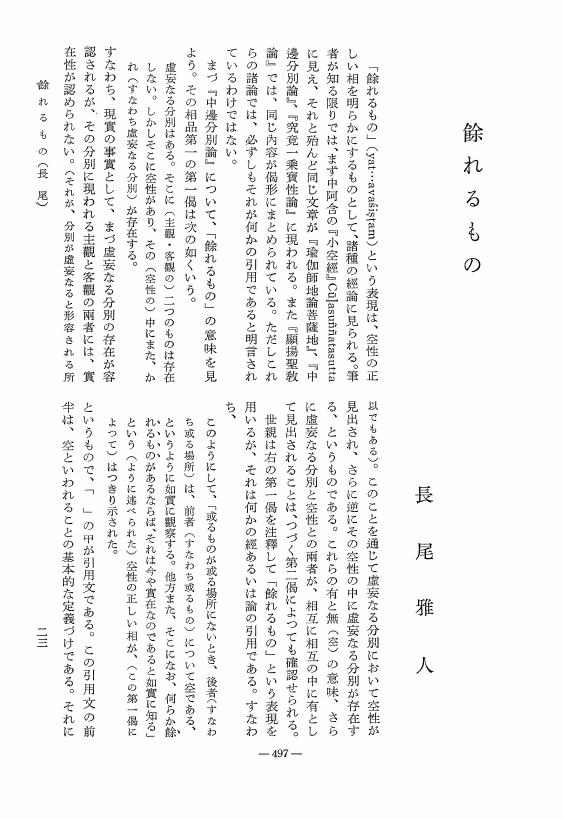4 0 0 0 OA 佛教的主體性について
- 著者
- 長尾 雅人
- 出版者
- JAPANESE ASSOCIATION OF INDIAN AND BUDDHIST STUDIES
- 雑誌
- 印度學佛教學研究 (ISSN:00194344)
- 巻号頁・発行日
- vol.1, no.1, pp.49-54, 1952-07-20 (Released:2010-03-09)
1 0 0 0 OA 世界観としての三性説 (昭和六十二年九月十四日 提出)
- 著者
- 長尾 雅人
- 出版者
- The Japan Academy
- 雑誌
- 日本學士院紀要 (ISSN:03880036)
- 巻号頁・発行日
- vol.43, no.1, pp.1-19, 1988 (Released:2007-06-22)
The three-nature theory was established by Yogacara teachers of Indian Mahayana Buddhism such as Asanga and Vasubandhu in the fourth to fifth century. It is a sort of Weltanschauung in which the world is considered to have three natures by which the way of emancipation from this deluded world to the world of enlightenment is theoretically systematized. The three natures are: imagined nature (parikalpita-svabhava), other-dependent nature (paratantra-svabhava), and consummated nature (parinispanna-svabhava). The world of our daily life is characterized as“(wrongly) imagined, ”for it is full of falsity, delusion, and bewilderment, when compared to the world of ultimate truth, or the Absolute, which is called the“consummated”world. It is“consummated”because such a world of ultimate truth does exist, not apart from this world, but only as a“consummated” state of this world, attained by human endeavor. Between these two worlds of the“imagined”and the“consummated”lies the third one which is called“other-dependent.”“Other-dependent”refers to the fact that all entities are mutually dependent, as elucidated by the Buddha in terms of“dependently co-arising”(pratityasamutpada).This theory, however, does not intend to set up three different worlds side by side; instead, it maintains that one and the same world turns around and becomes the imagined nature at one time and, on another occasion, becomes the consummated nature. And that which turns around, i.e., the one and the same world mentioned above, is the other-dependent nature. The principle of“convertibility”underlies and permeates this three-nature system. The other-dependent nature is the source for this convertibility, on the basis of which the turnabout of the imagined nature as well as that of the consummated nature can take place.Thus, the other-dependent nature occupies the central position in the three-nature theory. It is neutral because of being removed from both the imagined and the consummated, but it is also pure. In this way, it is not only the basis but also the mediator for the other two natures; it bridges the gap between the imagined nature and the consummated nature, bewilderment and enlightenment. In this connection, the three-nature theory also offers a logical foundation for doctrinal but paradoxical propositions such as“samsara is identical with nirvana.”Several similes, the simile of magic, of gold-ore, and of serpent-rope-hemp, clearly illustrate the significance and characteristics of the three-nature theory.
1 0 0 0 OA 餘れるもの
- 著者
- 長尾 雅人
- 出版者
- Japanese Association of Indian and Buddhist Studies
- 雑誌
- 印度學佛教學研究 (ISSN:00194344)
- 巻号頁・発行日
- vol.16, no.2, pp.497-501, 1968-03-31 (Released:2010-03-09)
1 0 0 0 OA 山口先生のチベット学
1 0 0 0 OA 法藏の三性説に對する若干の疑問
- 著者
- 長尾 雅人
- 出版者
- 京都大學文學部
- 雑誌
- 京都大學文學部研究紀要 (ISSN:04529774)
- 巻号頁・発行日
- vol.4, pp.183-205, 1956-11-20
この論文は国立情報学研究所の学術雑誌公開支援事業により電子化されました。


